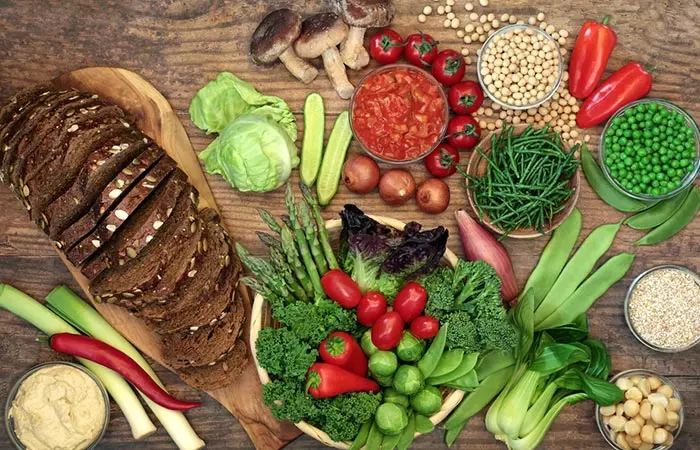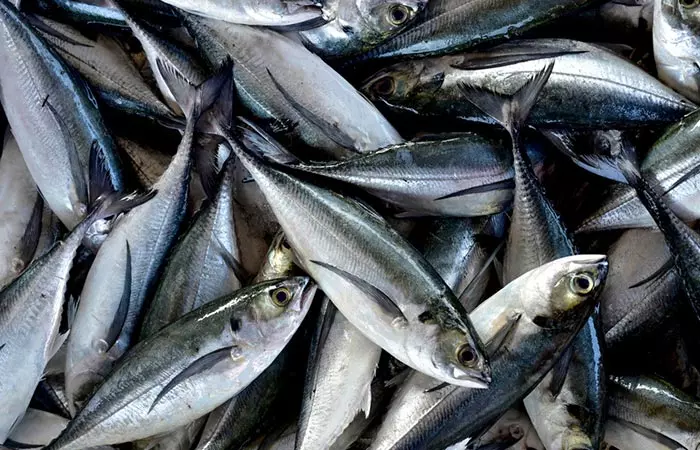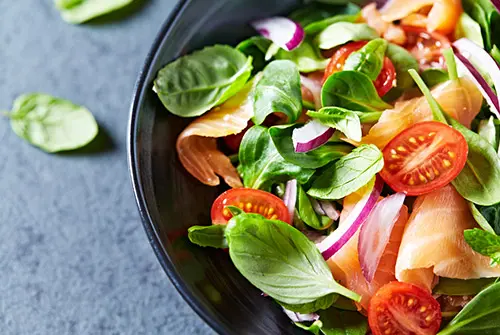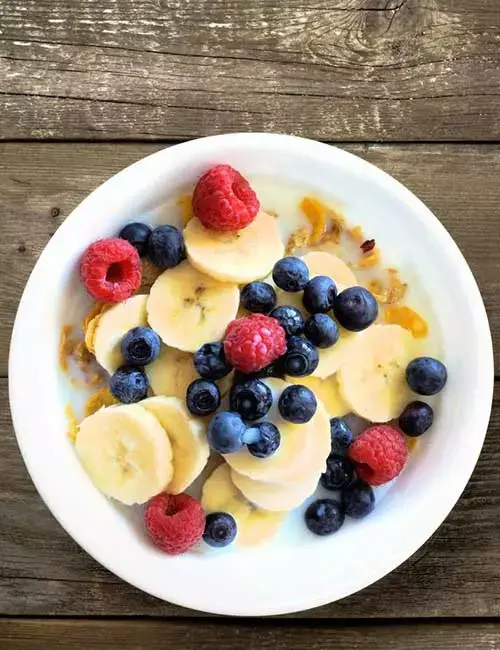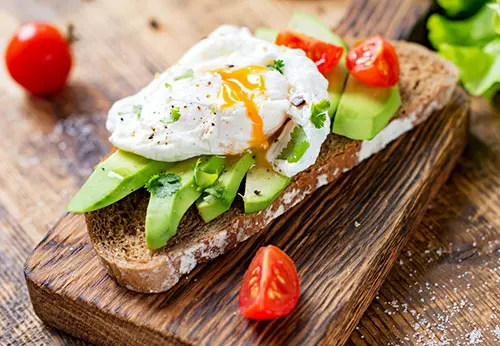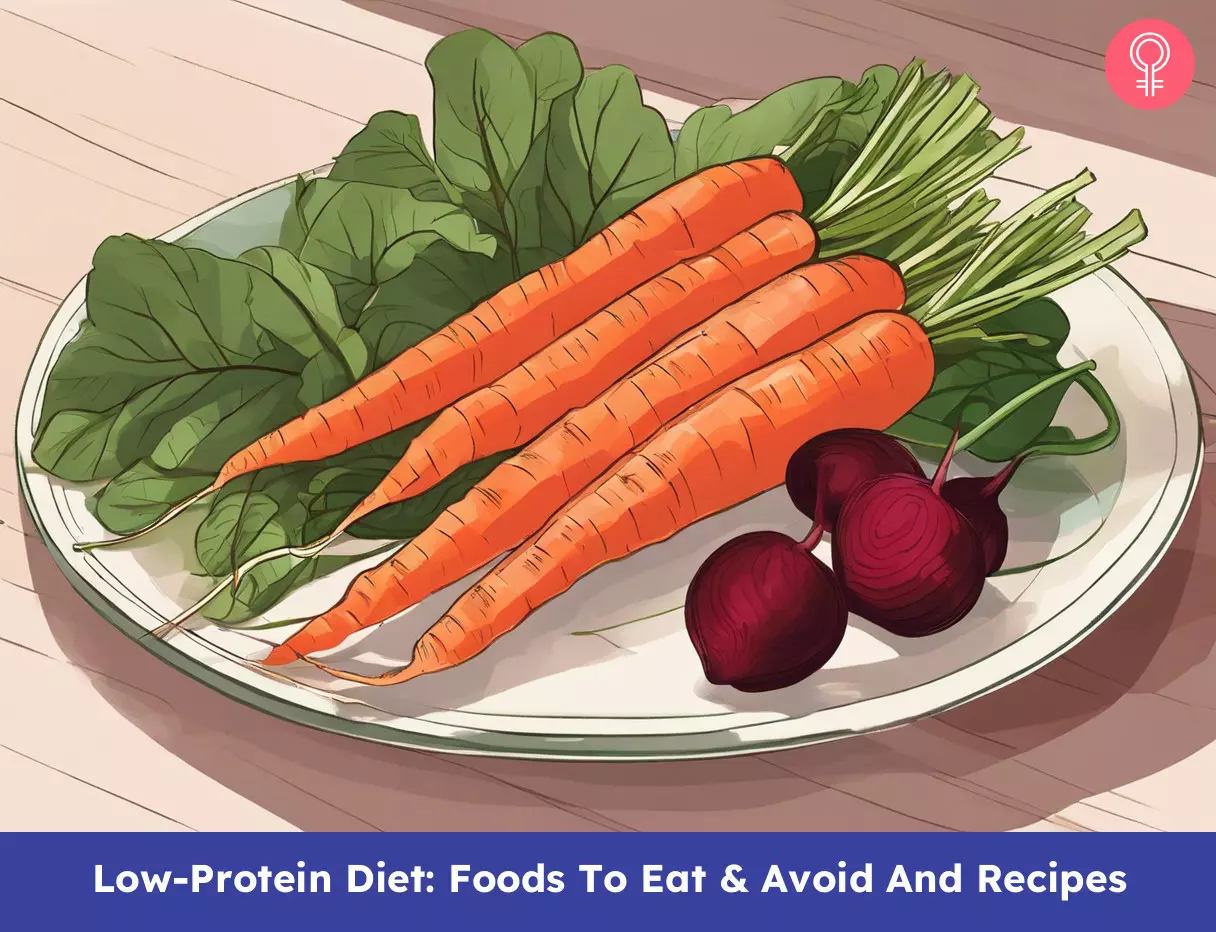Only under certain clinical conditions like poor kidney function, a liver condition, or inborn metabolic abnormalities should you consider following this diet. Even then, you need to do it under the supervision of a doctor and a nutritionist to follow the appropriate guidelines for this diet. In this post, you will learn everything you need to know about a low-protein diet. Scroll down for more information.
What Is A Low-Protein Diet?
An average healthy individual needs 10-15% (>0.8 g/kg body weight/d) of calories from protein, depending on the activity level (1). But in a low-protein diet, only about 20-50 g of protein (which is 0.5-0.6 g/kg body weight) per day is allowed, which amounts to 4-8% of the daily calorie requirement (2). Though protein is extremely vital for bodily functions, improving metabolic rates, and maintaining weight, a low-protein diet with a balanced dietary approach can also have a better effect on health conditions if you have any clinical disorders.
Who Should Follow A Low-Protein Diet?
People with certain metabolic disorders like phenylketonuriai A disorder that causes an amino acid buildup in the blood which can result in mental retardation, movement problems, and seizures. (PKU), maple syrup urinary disease, homocystinuriai An inherited disorder causing a harmful buildup of substances in the blood and urine during which the body is unable to process amino acids. , liver disorders, renal conditions, high levels of uric acid, or sensitivity to proteins need to follow a low-protein diet under proper supervision.
Why Is A Low-Protein Diet Important?
Vandana Sheth , RDN, CDCES, FAND, says, “A low protein diet can help delay the progression of chronic kidney disease. However, it’s important to also adequately meet your nutritional needs to avoid being malnourished. It’s best to consult with a registered dietitian to help design an appropriate plan.” A low-protein diet is effective in certain medical conditions rather than to stay healthy. Here are the benefits of a low protein diet:
1. Reduces Load On Kidneys
A low-protein diet is important for giving your kidneys rest and preventing toxic build-up in the body. When your protein intake exceeds the daily requirement, the excess protein is metabolized by the liver to produce the nitrogenous compound urea, which puts a burden on your kidneys (3). Your kidneys have to work 24/7 to flush out the urea load. Soon, your kidneys get stressed and become unable to metabolize proteins. As a result, urea gets accumulated in the body, leading to toxic results (4).
2. Effective For Inborn Errors Of Protein Metabolism
A low-protein diet slows down the degradation of protein metabolism, which helps to minimize symptoms of phenylketonuria and homocystinuria, genetic disorders associated with improper protein metabolism (5).
3. Improves Longevity
Foods high in protein, especially animal protein, impact protein metabolism and put a burden on your organs. Studies have found that foods low in protein and amino acids are strongly associated with improved longevity and metabolic health and reduction in the prevalence rates of cancer, cardiovascular disordersi A condition that affects the heart or blood vessels and results in abnormal blood flow, which may cause multiple blood clots. , diabetes (6), (7).
4. Reduces Uric Acid Synthesis
A low-protein diet is important for the treatment of painful gout (inflammatory arthritis caused by excess uric acid synthesis). A study conducted on diabetic rats on a low-protein diet showed a significant reduction in the formation of uric acid (8).
How Much Protein Should Be Taken In A Low Protein Diet?
Normally, your body requires about 40-60 g of protein every day (or 0.8 g of protein per kg body weight, depending on activity level) . So, if you weigh 60 kgs and do very little to no physical exercise, you will need 48 g of protein per day (9). In cases where a low-amino acid/protein diet is needed for medical reasons, you must reduce your protein consumption to 0.5-0.6 g/kg body weight based on the condition of your kidneys and requirement (2). Kayley Myers, RDN, says, “It is important to note that all our calories come from either carbohydrates, protein, and fat. If you lower your protein intake, you will need to increase the amount of carbs or fat that you eat. Protein is important for maintaining muscle mass, so low protein diets are usually only recommended to people with chronic kidney disease.”Consult your doctor for any clinical conditions.
List Of Low-Protein Foods
The bottom line during low-protein dietary management is to avoid consuming high-protein dietary sources and have foods that have low-protein content. What are they? Here’s a list of foods to eat and avoid on a low-protein diet.
Foods To Eat
Barbara Kovalenko , a nutritional consultant, says, “If you’re looking to design a low-protein diet, it’s important to focus on plant-based sources of protein, such as legumes, nuts, and seeds. You can also incorporate non-meat sources such as tofu, tempeh, and seitan which are good sources of protein. Some foods that do not contain protein include fruits, vegetables, and grains.” You must consume foods that are low in protein and have good nutritional value. Here’s the list:
Low-Protein Foods
Veggies – Kale, spinach, carrot, beetroot, scallions, radish greens, radish, turnip, parsnip, and pumpkin. Starches – Bread, pasta, cereals, croissants, bagel, muffin, rice cakes, noodles, and popcorn. (preferably whole grain unrefined starch variants that may also help people with kidney problems and diabetes).
These foods contain the lowest amounts of protein.
Fruits – Apple, banana, papaya, melon, peach, plum, grapes, oranges, lemon, lime, grapefruit, dried fruits, fruit juice, and frozen or canned fruit. Fats – Butter, margarine, mayonnaise, vegetable oil, olive oil, and salad dressing. Sugars – Candies, cake, marshmallow, lollipop, Danish, and granola bars. (though we recommend minimal consumption of these sugars). Beverages – Green tea, non-dairy beverages, soda, and water. Condiments – Vinegar, powdered garlic, powdered onion, fresh and dried herbs, and pepper.
Foods You Can Eat In Moderate Amounts
You will be allowed to consume the following high-protein foods, but only in very small amounts.
Animal Protein – Fish, meat, and eggs. Dairy – Milk, pudding, cream cheese, sour cream, and yogurt.
Tip: Consider having non-dairy milk products if you have already consumed the allowed amounts of dairy products for the day. In addition, always read the nutrition information provided for each product as some products have a higher protein content than others (like soy milk, which has 8g/serving Vs. almond milk, which has 1.3g/serving).
Foods To Avoid
Bacon Tartar sauce Meat tenderizers Ketchup Cooking wine Soy sauce Steak sauce Barbecue sauce Chili sauce Seasoned salt Sea salt
Tip: Avoid consuming high-sodium foods or sugary foods. Talk to your doctor to decide the allowed amount of each food. There are some foods that you can eat in moderate amounts. These include beans, soya, lentils, tofu, nuts, and nut butter. Now, let me tell you how you can plan your diet depending on the foods that you are allowed to eat.
Sample Low- Protein Diet Plan
Kovalenko says, “As for breakfast, a low-protein breakfast can include options, such as oatmeal with nuts and seeds, whole grain toast with nut butter, or a vegetable omelet made with tofu.” Here is a sample diet plan that you can follow to help with your meal planning: Meal planning is essential while following a low-protein diet. It will help you keep track of your protein intake and make sure you stay within your limits. This way, you can also enjoy different flavors and nutrients while keeping your meals balanced. You can follow this sample diet plan and the tips listed in the next section to eat normally and without feeling deprived.
How To Easily Integrate A Low-Protein Diet Into Your Routine
Initially, going on a low-protein diet may seem like a drastic change. But if you know how to tweak your diet plan, it will only get easier to stay away from this essential macronutrient. Here’s what you can do.
Consume thin slices of meat – this cuts down the protein content. Consider the veggies in your salad as the main dish; the small amount of meat can be the high-protein source. Mostly use non-dairy products. Decrease the meat when you make a casserole. Consume vegetable lasagna. While making wraps and sandwiches, avoid using shrimps and big chunks of meat.
Calorie Boosters
These are foods that will help you maintain a healthy weight when you are on a nutritional restriction. Here’s what you can eat:
Fats – Consume olive oil, mayonnaise, and rice bran oil. Sugar – Add sugar to your diet in the form of jellies, jelly beans, jam, jelly, syrups, gummies, and hard candy. Frozen/Canned Foods – Canned or frozen fruits and veggies are high in calories and can act as calorie boosters when you are on a low-protein diet.
Using these foods will not drastically drop the number of calories you consume, thereby protecting you from weak immunity and fatigue. Also, consult your doctor regarding the quantity of intake to prevent overconsumption. Now, let’s talk about the most exciting part. Scroll down to find out what it is.
Low-Protein Recipes
1. Vegetable And Salmon Salad
¼ cup baby spinach ¼ cup rocket spinach ¼ cup collard greens 1 oz smoked salmon, thinly sliced 1 tablespoon chopped cilantro 4 tablespoons mayonnaise 1 teaspoon honey 1 tablespoon lime juice 1 teaspoon chili flakes Salt to taste
2. Flat Rice Breakfast Bowl
½ cup of flat rice 1 cup non-dairy milk ½ cup blueberries ½ cup raspberries 1 small banana, sliced 1 teaspoon of cocoa powder 2-3 tablespoons maple syrup
3. Low-Protein Egg And Avocado Toast
½ boiled egg 1 slice of wheat bread ½ avocado 2 tablespoon mayonnaise Salt and pepper
Risks Associated With A Low-Protein Diet
Following a low-protein diet on a continuous basis affects the vital functions of cells, such as wound healing and immune response (11). A low-protein diet can lead to muscle loss (11). Finally, this diet is low in iron, calcium, thiamine (vitamin B1), riboflavin (vitamin B2), and niacin (vitamin B3) – and hence, you would need nutritional supplements to sustain normal body functions. But, speak to your doctor before taking any supplements. Increases the risk of infections (12). It can harm the heart if sugar and fat sources are not monitored. May lead to tooth decay. The low-protein diet reduces serum albumin levelsi Albumin is a protein produced by the liver. Albumin levels refer to the amount of albumin present in the blood. , which causes edema (accumulation of water in extremities) (12).
To prevent these risks, it is best to consult a doctor before getting into this diet. Read on to learn more about it.
Consultations With Healthcare Professionals
You must talk to your doctor before you start a low-protein diet. Kovalenko adds, “It’s important to note that a low-protein diet may not be right for everyone, and it’s always best to consult with a doctor or dietitian before making any significant changes to your diet. With the right guidance, you can ensure that you’re getting the right amount of protein for your individual needs and reap the benefits that come with it.” A healthcare professional can advise you on how to adjust the diet as per your body’s needs and your lifestyle. They can also help keep track of your progress to ensure you get all the nutrients you need while managing any health conditions. This way, you can follow your diet safely and effectively. To avoid any mishaps, we have put together a list of general precautions below that you can bookmark and keep handy.
Precautions To Be Taken On A Low-Protein Diet
A low-protein diet should be followed under strict medical guidance from a dietitian who is familiar with liver and kidney diseases. The diet should be designed in a way to meet the nutritional and dietary needs of the individual and cut down the workload on the kidneys. The diet should not eliminate protein-rich foods like eggs, meat, and cheese.
Which foods do not contain protein? Eva De Angelis, a dietitian-nutritionist, says, “All kinds of fruits and veggies, except for peas, fresh beans, and corn, and healthy fat sources like avocado and olive oil are pretty much protein-free. We have some grains like rice, oats, bread, pasta, and barley with moderate amounts of protein, so they are also ok for a low-protein diet.” What is a low-protein breakfast? Jen Hernandez, Registered Dietitian and board-certified in renal nutrition, says, “An example of a low-protein breakfast could include coconut yogurt topped with fresh berries and granola. Another example could be gluten-free avocado toast with preferred spices and seasonings on top, paired with a side of fruit.” Why do kidney patients need a low-protein diet? A moderate- to high-protein diet produces waste products that need to be eliminated by the kidneys. To reduce this load on the kidneys, a low-protein diet is suggested to kidney patients. Are potatoes low in protein? Potatoes are starchy vegetables that have comparatively lesser protein (13). Thus, they can be added to a low-protein diet plan as well as a low-fiber diet. Can you lose weight on a low-protein diet? Yes, but that might happen through a loss of muscle mass, which is not recommended. Consult your doctor before you start a low-protein diet exclusively for losing weight. Will a low-protein diet help with inherited metabolic disorders? Yes, a low-protein diet is recommended for those with phenylketonuria and homocystinuria. Consult a doctor to find out the amount of protein you can have per day. Do tomatoes have protein? Yes, 100 g of tomatoes contain only 0.88g of protein. This makes them an excellent addition to your low-protein diet (14).
Illustration: Low-Protein Diet : Foods To Eat & Avoid And Recipes
Start your day right with some delicious and nutritious low protein breakfast! Watch this video for quick and easy recipies for a filling and enjoyable first meal of the day.
